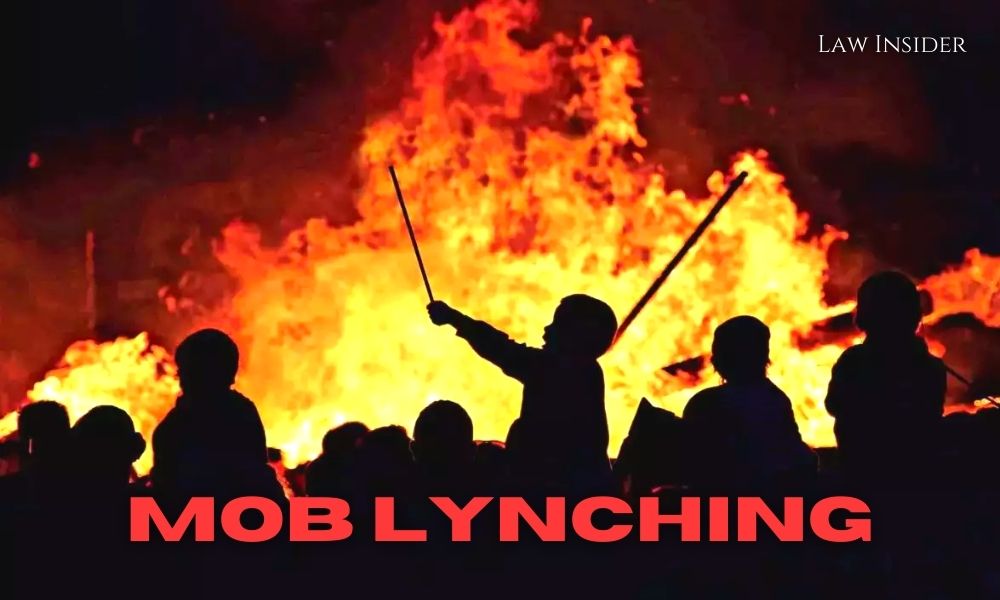By Arryan Mohanty
Published On: April 30, 2022 at 17:32 IST
The Rig Veda, the world’s oldest and greatest manuscript, establishes that: ‘O men! Go together in harmony; converse together; understand one another’s thoughts’.
It is inexcusable that the country to which these books belong engages in the hate crime of mob lynching and uses religion, among other things, as a justification for it.
In India, mob lynching has been condemned as a violation of the Sanatan Dharma’s traditions and, above all, of humanity. Mob Lynching challenges the very foundations of the law, which is a sine qua non for civilization.
According to an India Spend analysis, the number of incidences of mob lynching is increasing every year. The term ‘vigilance,’ according to the Cambridge dictionary, refers to law enforcement carried out by a self-appointed group of people without any legal authority.
People who want to enforce legal authority without any legal grounds are the ones who commit lynchings. A lynching occurs when a group of people kills a person, accusing him of committing an offense that is frequently motivated by religious prejudice or amusement.
When one community’s beliefs about an issue disagree with the views of the other community, an unlawful act of mob-lynching occurs as a result of the conflict.
In India, states like Uttar Pradesh, Haryana, Delhi, Gujarat, Karnataka, Rajasthan, and Madhya Pradesh have the largest number of cow-related mob attacks.
In India, mob lynching has been a crime with a latent threat looming over people’s heads. The majority fears the minority, and the minority fears the majority, creating a cycle of fear that leads to the crime of mob lynching.
While there are many factors that can contribute to mob lynching, religion and a lack of respect for and belief in the country’s legal system are at the top of the list. Misunderstanding historical ideas can also set the fire ablaze.
There is no codified law in India prohibiting mob lynching; however, Sub Section(a) of Section 223 of the Criminal Procedure Code, 1973 contains the relevant provision for persons being charged jointly for the same offense committed in the course of the same transaction that is applicable to two or more people. Those who are lynched are treated inhumanely. They are frequently beaten, chained, and hanged, resulting in serious injury or death.
This apprehension stems from a number of previous procedures. Since the founding of the Delhi Sultanate, there has been a rise in communal hostility in the so-called harmonious India. It has always been a superiority race since then.
During the invasion of India by sultans from other nations, Hinduism (India’s only religion at the time) suffered greatly, and people began to hunt each other down.
Fear has been instilled in both vigilante old and unformed young brains as a result of this never-ending struggle. The fight between Ramayana and Quran has hampered their understanding and knowledge as well.
The hate crime of mob lynching is wreaking havoc in India. The recent mob lynching of three persons in Maharashtra, including two sadhus, is an addition to this raging crisis.
The incident has elevated the issue of mob lynching to new heights. The diminishing of cops’ duties is a noteworthy characteristic of this recent mob lynching.
Not only if the three were not guilty of the claimed crimes, but even if they were, the police should have fought to save them since it is the police’s responsibility to ensure that those three people receive a fair trial in court and that no one takes the law into their own hands.
If the fact that those three people were truly guilty is accurate, and the police were aware of it, then the fact that no action was taken to protect them from the crowd suggests that even the police do not faith in the country’s judicial system.
Meaning of Mob-Lynching
Mob-lynching is one of those horrific crimes in which a person is targeted by a group of people, and the violence is equivalent to crimes against human body or property, both public and private.
It is a violent act in which a gang of people, acting together, target and illegally kill a person. The Supreme Court of India has referred to these mobs’ horrific acts of mobocracy as “Horrendous acts of Mobocracy.”
A person’s right to life, as defined by Article 21 of the Indian constitution, is also jeopardized. This is the most recent addition to the list of offenses.
This can even be classified as one of the worst types of crime because one person infringes on the rights of another in order to satisfy their own selfish motives.
Because there is no legal authority, it is frequently referred to as vigilante justice. The concept of compassion and justice is completely violated by such brutal violence and uncontrolled mob behavior.
When such traumatic situations occur, not only a single person is impacted, but the entire society is forced to deal with the effects.
The term ‘lynch’ refers to a self-made court that punishes a person without giving them a chance to defend themselves; such actions are based on religious prejudice or rumors, and the cause for this is a mentality clash between different communities.
Every act of criminality alters the core of justice in society. These are also known as extrajudicial punishments, in which the victim is assumed to be the perpetrator by the general public.
This word was derived from the name of a Virginia landowner named Charles Lynch, who was the head of an irregular court founded to punish loyalists during the American Revolution.
It has been noticed that rumors and misleading information are the primary causes of mob lynching in the majority of cases. While doing so, these individuals believe they are punishing the offender, but they forget that by acting in this way, they are taking law into their own hands. Only the concept of lynching arose from there.
When viewed from a broader perspective, mob lynching is a result of the terror that has been instilled in the minds of the people.
History of Mob Lynching
This tactic was developed in America, where it was originally used against black people with the primary goal of suppressing them. Following that, in the seventeenth century, when there were so many riots in England due to political unrest, so many occurrences of mob lynching were reported.
Violent group activities were quite common in the British Atlantic region, where group violence was thought to be harmless or non-toxic in terms of purpose. During the civil war, black individuals were hanged in America due to racial discrimination, while Mexicans were targeted in the southwest.
According to certain studies, there were 4730 people lynched in the United States of America between 1882 and 1951, with 3437 of them being black and 1293 being white, highlighting the racial turmoil in the country at the time.
When southern democrats regained power and began controlling state legislatures in 1892, the number of mob lynchings reached an all-time high.
However, by the end of the twentieth century, all southern states had passed new laws prohibiting blacks and poor whites from voting and isolating them from public life. During that time, the law was highly divisive, with 3500 black and 1300 white Americans lynched.
These occurrences have been on the rise for years, thanks to the backing of local law enforcement. It is one of the most improper practices because, many times, innocent individuals are forced to become victims as a result of rumors.
In addition, several German courts had rules for imposing fines or penalties in situations of lynching. To preserve public dread, these atrocities were performed in public so that the public’s conscience may be affected.
Mob lynching and violence can be found in every civilization and country, but especially in places like South Africa, Guatemala, and Brazil, where mob lynching rates are quite high.
Incidents of Mob Lynching in India
Internal tensions between different communities in India are the main causes of mob lynchings, whereby people from one ethnic minority group assault those from another ethnic minority group who are accused of committing a crime.
It has been noted that persons from the marginalized part are the eventual victims in the majority of incidents. For example, in the village of Kherlanji in the Bhandara region of Maharashtra, four Dalit families were assaulted and massacred by a few members of the Kunbi caste in 2006.
This episode occurred as a result of communal violence, and it is thought that it was caused by a fight between the upper and lower castes. According to reports, the Dalit family refused to give up their land for the construction of a road that would benefit the upper caste, and as a result, they were murdered.
Female Dalit family members were compelled to take off their garments. We don’t have particular rules in India to prevent mob lynching, however section 223(a) of the criminal process code of 1973 states that if the same allegations are brought against multiple people, they can all be held jointly accountable for the crime.
The following are some examples of mob lynchings that have shaken India:
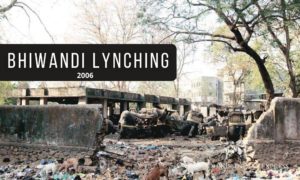
2006 Bhiwandi Mob lynching
It is a lynching case in which two police constables from the Bhiwandi region of Maharashtra’s Thane district were slain by a mob made up largely of Muslims.
It was interpreted as a retaliation for the police killing of two Muslim males. The killing of Muslim males boiled the people’s blood to the point where they stabbed both constables to death.
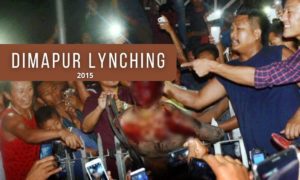
2015 Dimapur Mob lynching
On March 5, 2015, in Dimapur, Nagaland, a crowd of 8000 to 9000 people stormed the Dimapur central jail and attacked one of the inmates who had been charged with rape in one of the rape cases.
The enraged mob compelled him to strip naked in response to the rising number of rape and sexual harassment charges in the area.
Farid Khan and three of his buddies assaulted and intoxicated a twenty-year-old Shri Digambar Jain Girls College student on February 23, 2015, and afterwards raped her multiple times. They even offered her a payment to be quiet.
An FIR was filed against all of them on February 25th under sections 476, 363, and 344 of the Indian Penal Code. During the trial, they all said it was consenting intercourse because money was exchanged for the same thing.
The enraged mob lost control and showered all of the accused with stones, dragging him for almost 7 kilometers before killing him on the way to the clock tower. His body was then displayed on the clock tower so that no one would dare to do it against a girl in the future.
Police had to use tear gas and blanks to keep the mob under control. During the altercation, 52 police officers were injured, and ten of their vehicles were set on fire. The mob believed that the state’s justice system was broken and that instant action was required, hence it was the correct thing to do.
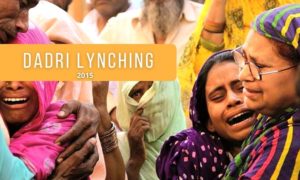
2015 Dadri Mob Lynching
It is a case in which residents from Bisara village, near Dadri in Uttar Pradesh, attacked Mohammed Akhlaq, a fifty-two-year-old man, on suspicion of slaughtering a cow.
Residents of Bisara village assaulted Mohammad Akhlaq on the fateful night of September 28, 2015, because they suspected him of stealing and butchering cows.
Bricks and knives were thrown at him. He was unable to bear those bodily injuries as a result of this violent deed, and he died; his twenty-year-old son Danish was also severely injured.
When the case was brought before the court, they stated that, first and foremost, the evidence of the meat could indicate whether the meat was meat or beef, and that the meat was assured to be cow meat in the forensic lab.
However, in this case, the court found Mohammad Akhlaq not guilty because the beef was not fit for human consumption. Following the lynching, there were political reactions from all throughout the country. As a result, the family received monetary recompense.
2016 Jharkhand Mob lynching
Two Muslim cattle traders, Ansari, 32, and Imtiaz Khan, 12, both of Jharkhand, were hung from a tree in 2016 because a crowd claimed they were murdering livestock.
According to the villagers, the point of contention here was that there was some community animosity in the area about beef consumption. As per the Jharkhand Vikas Morcha, this incident raises serious questions about humanity. The defendants were taken to trial by the Jharkhand police after a few days.
2017 Alwar Mob Lynching case
In 2017, a dairy farmer named Pehlu Khan from Haryana’s Nuh District was killed while returning to his hometown, and six of Pehlu Khan’s colleagues were also viciously tortured.
They had the relevant documentation to indicate that cows were purchased for the purpose of dairy farming, according to his son’s comments, but the mob contradicted all of their assertions and tore all of the documents.
His father and others were dragged out of the automobile in front of his eyes, beaten with sticks and rods, and he died as a result of his injuries. People’s souls were torn apart by a series of mob lynchings, which they denounced and even demanded harsh consequences for.
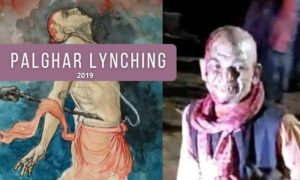
2019 Palghar Mob lynching
The recent Palghar mob lynching case, in which two Juna Akhara Hindu sadhus and their driver were beaten in Maharashtra’s Palghar district in 2020 because all three of them were mistaken for kid thieves after rumours circulated over WhatsApp that several criminals were roaming the locality.
When the police intervened and tried to prevent them from taking the law into their own hands, they were beaten up by the mob as well. The Maharashtra administration got widespread condemnation and backlash as a result of this.
115 villagers were later detained on criminal charges, but they all claimed to be innocent, claiming that they mistook the sadhus and drivers for kidnappers and organ harvesting gangs. The fact that the vehicle arrived at night only added to their suspicions that they were kidnappers.
Given the seriousness of the crime, India’s National Human Rights Commission requested that the Mumbai police chief provide detailed data on what action was done against the perpetrators and how much compensation was awarded to the victim’s family.
Reasons of Mob Lynching
- There are insufficient laws in the Indian penal code and criminal procedural code to deal with this major problem.
- Laws protecting minorities and persons from lower castes are not sufficiently applied.
- Police officers are subjected to a great deal of political pressure.
- Intolerance against a particular group is growing by the day, and misinformation is spreading as a result of people’s growing anger.
- With the rising unemployment rate, youth are easily misled by political and religious forces.
- Another reason that these mob lynching events are documented is that there is a bias against a particular class.
- Personal animosity between various groups.
- One of the factors that encourages people to choose this manner of dispensing justice is the low conviction rate.
- Fake news is widely spread on social media, which in turn encourages the masses.
- Social tensions such as class, caste, and religious conflict are deeply rooted in the minds of Indian citizens, and it is for this reason that the marginalized are driven into a never-ending cycle of injustice.
Impact of Mob-Lynching on the Society
This act of people taking the law into their own hands due to a lack of understanding of the justice system poses a severe danger to the Rule of Law and Natural Justice concepts.
Such activities have also posed a major threat to the country’s minority populations, and adequate measures must be made to prevent and deter such crimes.
Furthermore, vigilantes with some political affiliations to right-wing groups have perpetrated acts of violence, believing themselves to be politically proper while doing so.
Across the country, mob violence has frequently resulted in the promotion of majoritarianism by propagating the majority’s values while limiting minorities’ basic rights.
People taking justice into their own hands in a country like India is unacceptable, because inhabitants of the country have been awarded many fundamental rights, and such lynching cases are an affront to their right to life, right to a fair trial, and so on.
India is a secular country, thus it’s critical to ensure that minorities’ rights are maintained and that the majority does not oppress them.
Judiciary on Mob-Lynching
In the case of Tehseen S. Poonawalla v. Union of India & others, the Hon’ble Chief Justice of India, Dipak Mishra, and the three-judge bench denounced recent occurrences of mob lynching and mob attacks on Dalits and members of other communities.
On July 17, 2018, he asked the parliament to drought and enact laws that would make mob lynching a separate crime and set punishments that would serve as a deterrent to future lynchings.
Furthermore, the bench argued that no one or group of individuals can take the law of the land into their own hands and impose punishment that they are not obligated to impose. Furthermore, the Chief Justice of India underlined the necessity of issuing orders for punitive, rehabilitative, and preventative measures.
These actions are being taken in response to the social activist’s Writ Petition, which was filed under Article 32 of the Indian Constitution. He advocated swift and decisive action against the mob lynchings perpetrated by cow protection organizations that engage in excessive violence.
The petition even demanded that violent content shared by the groups be removed from social media. Governments must take stringent steps to avoid mob violence and vigilantism, and citizens should report incidents of people taking the law into their own hands.
The Central government has moved the Supreme Court of India in the aforementioned case in order to execute the rules for the crime of mob violence. As a result of the interim order, the Supreme Court’s full bench has directed specific actions in order to deal with this particular matter. The following are the measures: –
- In each of these locations, the state government shall nominate a senior police officer who is not below the rank of Superintendent of Police. Every district requires the appointment of a Nodal officer. Furthermore, in order to prevent mob violence in the appropriate district, this officer will be assisted by a police officer with the rank of Deputy Superintendent of Police. The Supreme Court also urged that a Special Task Force be established to drought reports on persons suspected of committing such crimes or distributing false information, hate speech, or other offensive utterances.
- The district’s newly appointed police officer will be responsible for dispersing a mob that is on the verge of committing mob lynching by using the powers granted to him under Section 129 of the Criminal Procedure Code.
- Moreover, state and federal governments will be required to take appropriate measures, such as broadcasting on media platforms, radio and television stations, and official websites that any form of mob lynching or mob violence is a punishable offense under the Indian Penal Code, and that those who commit it will face severe penalties, including life imprisonment.
- Following a court decision in favor of the victims, the state government must prepare a compensation plan for mob lynching or mob violence victims in accordance with Section 357A of the Code of Criminal Procedure Code, and such compensation must be provided to the victim or his family members within one month of the decision.
- To establish a relevant example in situations of mob lynching and mob violence, the court must condemn the guilty with the highest penalty for the commission of the crime in line with the relevant sections of the Indian Penal Code, which would serve as a deterrent to others who commit such crimes.
- Besides that, if the police or district administration fails to follow the above guidelines or instructions in preventing the crime of violence and lynching or conducting any investigation, it must be considered an act of disobedience on the part of the police officer, and negligence action must be taken against him.
Because of the ongoing armed Maoist insurgency, the State of Chhattisgarh alleged a number of human rights abuses for the inhabitants of Dantewada District and its neighbouring territories in the case of Nandini Sundar and others v. State of Chhattisgarh.
To combat this, the government of Chhattisgarh employed a local tribal youth organization as Special Police Officers (SPOs) and armed them to battle the Maoists. The authorities claimed that arming tribal people in accordance with the Indian Constitution is the right thing to do in order to combat “extremist Maoists.”
In this decision, the Supreme Court stated that it is the State’s duty to strive, continuously and consistently, to create fraternity among all people so that each citizen’s dignity can be maintained, promoted, and nurtured.
As a result, it is the state’s responsibility to prevent crime in the state in order to maintain complete social harmony.
A writ petition was filed at the Supreme Court in the case of Mohd. Haroon and others v. Union of India and another in regard to the riots in District Muzaffarnagar, Uttar Pradesh.
There was communal tension in the city, and people were forced to flee their houses due to anxiety and terror. The petitioners, in this case, argued that the local administration instead of enforcing the law permitted the congregation to take place irresponsibly and also neglected to monitor its operations.
Further, it was also held that the victims of mob lynching cannot be discriminated against on the basis of the community or any religion.
Communities must get assistance in the form of rehabilitation and compensation. The Supreme Court also stated that it is the responsibility of the State Administration, in collaboration with relevant intelligence agencies from both the Center and the State, to prevent communal violence in all parts of the State.
Any officer in charge of preserving peace and order in the state who is proven to be careless will be penalised according to the law.
Furthermore, in the case of Archbishop Raphael Cheenath S.V.D v. the State of Orissa and another, a Writ Petition was filed before the court to highlight the State of Orissa’s failure to deploy police force to maintain law and order in Kandhamal District of Orissa and to protect its people when Swami Laxmananda Saraswati was assassinated by Maoists.
In this case, the court stated that the state government must investigate and determine the reasons of communal riots, as well as reinforce the police infrastructure, in order to prevent communal unrest. The court emphasized the state’s peace-building efforts.
Punishment for the Offense of Mob-Lynching
In our country, there is no explicit law or legal provision dealing with lynching or mob violence. However, the following statutes, which are currently part of the Indian Penal Code, provide for the punishment of mob lynching:
- Section 302 of the Indian Penal Code deals with the penalty for murder. It said that anyone who commits murder will be punished with either life imprisonment or death. In many circumstances, the convict may face further punishment.
- Section 304 of the Indian Penal Code (IPC) deals with the punishment for negligent homicide that does not equal to murder. The following are examples of possible punishments:
- Life Imprisonment –
- For the crime done or likely to cause the death of a person, the defendant can be sentenced to 10 years in prison and fined accordingly.
- Section 325 of the IPC outlines the penalty for causing serious bodily harm to another person willfully. Under the provisions of this section, a person who causes serious harm voluntarily, except in the case of provocation (as defined in section 335), is likely to be punished by imprisonment for a term of up to seven years and a fine.
- Section 120 B of the Indian Penal Code describes the penalties for parties who conspire to commit a crime together. It specifies that:
- If the offender conspires for an offense punishable by life imprisonment, death, or a sentence of two years or more in prison, the offender will be punished in the same way as if the offender abets the offender while committing the offense.
- If the offender conspires to commit a crime that is not punishable by death, life imprisonment, or a sentence of more than two years in prison, the offender faces up to six months in prison, a fine, or both if the crime is not punishable by death, life imprisonment, or a sentence of more than two years in prison.
Conclusion
Mob lynching can occur for a variety of causes. Witch-hunting was one of the causes of mob violence, with 2000 mentally ill women being murdered because of rumors accusing them of kidnapping and murdering children.
In India, religious conflagrations such as the 1984 Sikh riots, Anti-Muslim riots in Gujarat, or the lynching of Ghulam Muhammad by Hindu Yuva Vahini over his relationship with a Hindu girl in the neighborhood have had a negative impact on the country.
To avoid such situations, persons who are responsible for enforcing the laws must be made aware that they are violating other people’s rights due to a lack of knowledge of justice.
As a result of such a case, the Indian people have learned to bear justice with an overwhelming sense of foreboding that has amounted to a lurking, unidentified, unsaid fear.
Because of its extreme character, it has instilled dread in the minds of the public that they will be attacked by mobs and that they will be susceptible in the circumstance. Sadly, India has seen countless mob lynching and mob violence cases reported from different regions of the country.
The majority of the incidents occurred as a result of the country’s government’s beef-ban orders. It might be argued that all lynchings motivated by race or ethnicity discriminate against the entire community, in violation of Articles 14 and 15 of the Indian Constitution.
The current state of mob violence in the country is deplorable, and special legislation is required to protect victims of mob violence as well as to enforce tight processes to prevent attacks and punish wrongdoers engaging in mob violence.
References
report-mob-lynching-7-instances-which-shook-india
jharkhand-rights-forum-alleges-29-mob-lynching-cases-in-five-years
rule-of-mob-on-mob-lynching-in-several-states
states-views-sought-on-need-for-mob-lynching-law
mob-lynching-crime-awaiting-remedy

